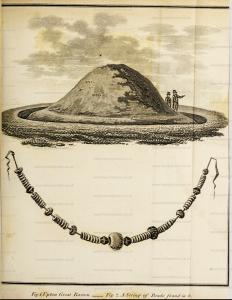Archaeologia Volume 15 Section XI Page 126
Archaeologia Volume 15 Section XI Page 126 is in Archaeologia Volume 15.
Description of the opening of Golden Barrow aka Upton Lovell 2e [Map] by William Cunnington (age 51).

Heytesbury, June 29, 1803.
Sir
On my return from Stonehenge last Wednesday, (where I had been to open some barrows with Mr. Coxe) I was surprised to find a large string of beads, which had been taken out of the large barrow on Upton-Lovell Downs near you. This barrow is bell-shaped, surrounded with a deep ditch, and small vallum, the diameter at the base is 105 feet, its elevation 11 feet, and from its large size is called Upton Great Barrow [Map]. [e] On enquiry I found it had been opened in my absence by a labouring man, who is often employed, in digging flints on those Downs for the turnpike roads; his views were the hopes of finding treasure, but on finding nothing but burnt bones and the beads, he sent for me; but being absent, my brother and one of my daughters went, and having persuaded him to defist from further pursuits till my return, they brought away the beads. When I saw the barrow, I found he had made a large trench near the centre, when, at the depth of nearly eleven feet, he found a circular cist in the native chalk; this contained burnt human bones, with which were deposited 48 beads; of these 16 were of green and blue glass [f] "in long pieces notched between, so as to resemble a string of beads," 5 were of canal-coal or jet, and the remaining 57 of red amber; among the latter was one of a large size; the very small ones fell to pieces soon after their exposure to the air, but the large ones are in good preservation. Mr. Crocker has drawn a sample of each very accurately, as you will see on comparing. A neighbouring farmer, Mr. Baker of Chiltern, having brought two labourers to assist; these with the same man worked all day in making further researches, but we were not able to discover any thing else, except a variety of animal bones; and abundance of black ashes and charred wood. I am therefore of opinion that this large tumulus was erected over the remains of some illustrious female, for such the beads indicate; had there been more than one interment, I think we should certainly have discovered them, as we made some very large sections in those parts of the barrow where they are generally found.
I am very respectfully.
Sir,
Your faithful Servant,
William Cunnington.
Note e. I have accompanied this with a drawing of the barrow, and part of the beads, by Mr. Crocker, and request your acceptance of them.
Note f. Theese are finely coated with the Armatura acquired by lying a length of time in the earth.
